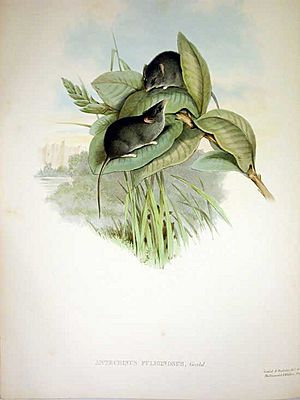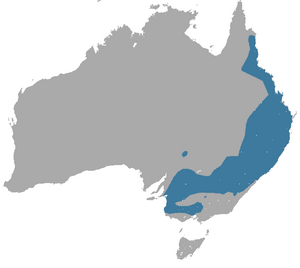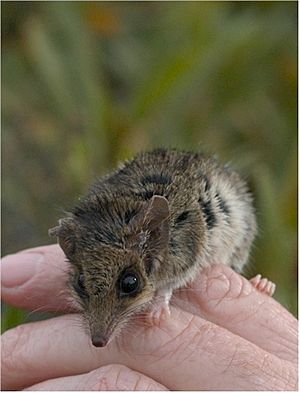Slender-tailed dunnart facts for kids
Quick facts for kids Slender-tailed dunnart |
|
|---|---|
 |
|
| Conservation status | |
| Scientific classification | |
| Genus: |
Sminthopsis
|
| Species: |
murina
|
 |
|
| Slender-tailed dunnart range | |
The slender-tailed dunnart (Sminthopsis murina) is a small, mouse-like marsupial from Australia. It is also known as the common dunnart. These animals are part of a family called dasyurids.
Slender-tailed dunnarts are usually 7 to 12 centimeters (about 3 to 5 inches) long, not including their tail. Their tail can be 5.5 to 13 centimeters (about 2 to 5 inches) long. Males weigh a bit more than females, with males being 25–40.8 grams and females 16.5–25.4 grams.
Contents
Where Slender-tailed Dunnarts Live
The slender-tailed dunnart lives along the east and south-east coasts of Australia. They can be found from the Cape York Peninsula down to the Port Lincoln area in South Australia.
There are two main types, or subspecies, of this dunnart:
- S. m. murina is found across most of their range.
- S. mu. tatei lives in Queensland, between Townsville and Cairns.
These dunnarts prefer to live in places that are 60 to 360 meters (about 200 to 1,200 feet) above sea level. They like areas that get about 30 to 85 centimeters (about 12 to 33 inches) of rain each year. Their homes can include dry forests, woodlands, and heathlands. These areas often have lots of fallen leaves and bark on the ground. In Queensland, they might even live near rainforest edges or swamps.
Breeding and Life Cycle
Slender-tailed dunnarts usually start their breeding season in New South Wales between September and March. Female dunnarts can have a second group of babies after their first ones are old enough to leave their mother.
A female dunnart might live long enough to breed in a second year. However, male dunnarts often die after they have mated. The babies, called joeys, develop inside the mother for about 12.5 days. They then stay with their mother and drink milk for 60–65 days. A mother dunnart usually has 8 to 10 joeys in one litter.
Sometimes, if food is scarce or the weather is very bad, dunnarts can go into a special sleep called torpor. This helps them save energy. Slender-tailed dunnarts are also nocturnal, meaning they are active mostly at night.
What Slender-tailed Dunnarts Eat
Slender-tailed dunnarts are not picky eaters when it comes to arthropods. They will eat many different types of insects and other small creatures. However, they seem to especially like beetles and moths. They might eat other prey less often, even if those are available.
See also
 In Spanish: Ratón marsupial de cola esbelta para niños
In Spanish: Ratón marsupial de cola esbelta para niños



